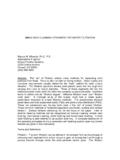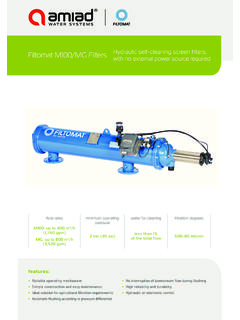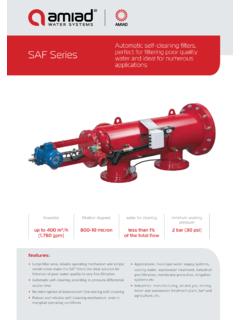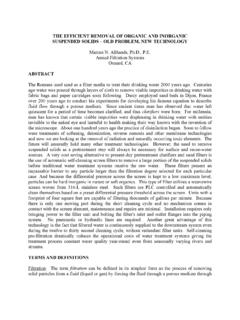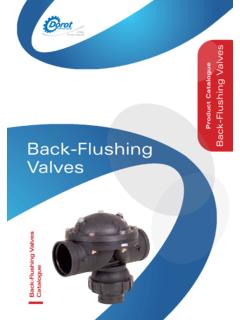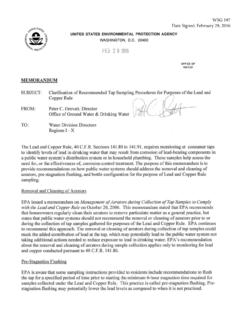Transcription of Removing Solids with Automatic Self-Cleaning Filters
1 THE 15TH ANNUAL PRODUCED WATER SEMINAR. Nassau Bay Hilton Hotel 3000 Nasa Road One Houston, Texas 77058. January 19-21, 2005. Marcus N. Allhands, , Senior Application Engineer Amiad Filtration Systems 2220 Celsius Avenue Oxnard, CA 93030. (805) 377-8580. Removing Solids with Automatic Self-Cleaning Filters Introduction The art of filtration utilizes many methods for separating solid particles from fluids. There is often no right or wrong method. Water quality and customer requirements usually determine the best method for each unique situation.
2 Ridged screens, pleated cartridges, string wound cartridges, melt blown cartridges, woven fabrics, non woven fabrics, sintered metals, granular media, frizzy balls and membranes are just some of the types of Filters available today. This plethora of filter types are often employed to do the same thing - remove suspended Solids from a stream of water. This manuscript will concentrate on only Automatic Self-Cleaning screen Filters and their properties. Aside from all the advantages of screen filtration, one of the biggest hindrances to their use is their tendency to clog quickly and need for frequent cleaning .
3 There are a number of Automatic methods in practice to eliminate the need for labor when cleaning the permanent screens in this class of filter . However, some work better than others. This paper will discuss one type of Automatic Self-Cleaning screen filter having a proven record with tens-of-thousands of successful installations around the world. Terms and Definitions The term filtration can be defined in its simplest form as the process of Removing solid particles from a fluid (liquid or gas) by forcing the fluid through a porous medium through which the solid particles are too large to pass.
4 Straining or sieving are terms often associated with this process. Typical solid particles found in screen filtration applications may include coarse sands and pipe scale thousands of microns in diameter to pollens, silts and algae which may be ten microns or less in size. Macro-filtration refers to the removal of particles greater than approximately 10 microns in size. Therefore, most screen Filters perform macro-filtration. The smallest particle size requiring removal from the fluid stream in a specific application is called the filtration degree.
5 Two conventions are used to define filtration degree. The first is taken from the textile industry. In that industry the density of a woven material is expressed as the number of threads per linear inch referred to as mesh. In the field of filtration the term mesh has come to mean the number of pores or openings per linear inch in the screen media. Although still in common use, the term "mesh" is not a true parameter of the screen since the actual opening or pore size depends on the diameter of the threads or wires and the type of weave used in the screen manufacturing process.
6 The second and more preferred convention used to describe nominal filtration degree is an actual linear dimension of the shortest distance (length or width) across an individual opening or pore of the filter medium. This is most often given in microns; 1/1000 millimeter or inches. The total area of the filter medium that is exposed to fluid flow and is usable for the filtration process is referred to as the effective filtration area. Any structural member or other solid barrier that prevents fluid flow and particle separation from occurring over any surface area of the filter medium is not included in the effective filtration area.
7 This parameter is very important when comparing different makes and models of Filters . Screens There are two basic types of screens in the industry. The first is called wedge-wire screen and is formed by laying stainless steel wires, having trapezoidal shaped cross-sections, parallel to one another with a small gap between them. The openings therefore are long slots with the width of the slot the nominal filtration degree as shown in Figure 1. Gap is filtration Wedge-wire degree Figure 1: Wedge-wire Notice that with a wedge-wire screen the shape of the target particles will greatly influence the efficiency of removal.
8 Three dimensional hard particles will be removed at a much greater efficiency than flat scaly particles that could orient themselves to slip through the slots. 2. Weave-wire screens on the other hand, have a discrete opening. A simple two dimensional square-weave would have rectangular openings. Some manufacturers of square-weave material form a rectangular opening with the length of the rectangle to 5 times longer than the width. Again, this can greatly affect the efficiency of the filtration process.
9 The best square-weave is one with rectangular openings having the length and width of the rectangle equal defining a true square as shown in Figure 2. Figure 2: Square Weave However, most screens today do not use a square-weave but other weaves such as Dutch Weave and Double Dutch Weave. Figure 3 shows an example of Dutch Weave. Figure 3: Dutch Weave Note that the openings are not rectangles but can best be described as three dimensional warped triangles. This type of weave is stronger at small filtration degrees than a simple square weave.
10 Weave-wire 316L stainless steel screens are strong and long lasting, capable of withstanding a pressure differential across the screen of up to 250 psi with no distortion. Filtration degrees are available from 3500 microns down to 10 microns. 3. Another important definition needed when designing or comparing Filters is the filtration open area. This is the pore area or sum of all the areas of all the holes in the filter medium through which the fluid can pass. Filtration open area is often expressed as a percentage of the effective filtration area.
